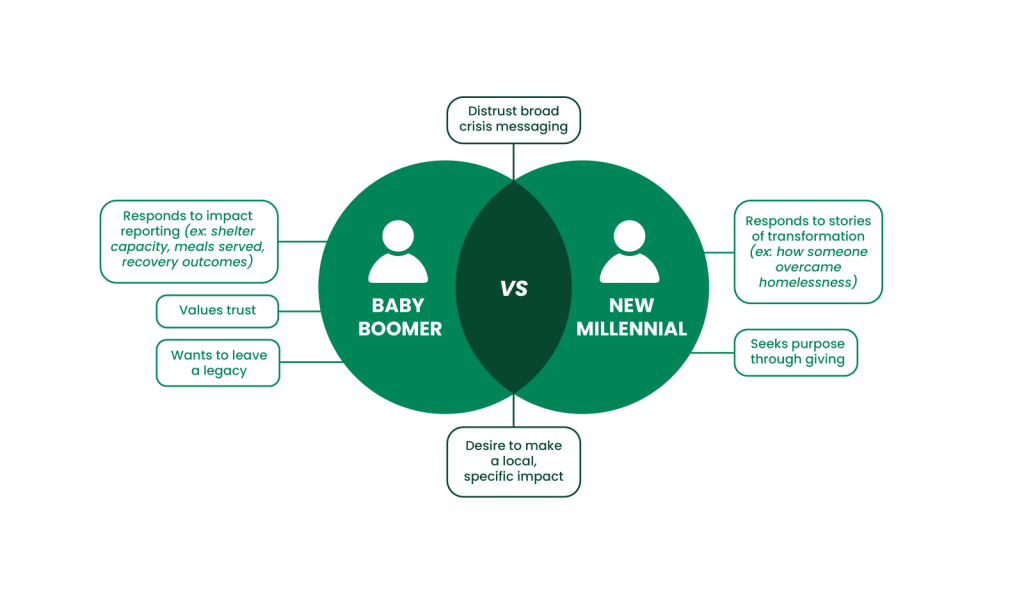The Donor Strategy Trifecta That Transforms Giving
By Nicole Ige-Hutto, Sr. Director Digital Strategy
Successful nonprofit marketing doesn’t begin with your message – it begins with your audience.
To truly inspire generosity, we must first be curious about who our donors are and what they care about. Donors don’t give because we ask. They give because they feel seen, heard and understood.
This is where the Donor Strategy Trifecta comes in. Bringing together persona research, social listening and donor feedback, this 3-pronged approach helps unlock deeper donor connections.
Donor Insights = Smarter Fundraising
Fundraisers have long talked about “knowing your donor,” but in practice, this often amounts to looking at transactional data – recency, frequency and dollar amount. While helpful, that’s only part of the picture.
Get curious about who your donors really are! Today’s donors are values-driven, digitally immersed and increasingly selective about the causes they support. To connect with them, organizations need to deeply understand:
- What motivates their giving
- What channels they trust
- What stories resonate
- What language and tone fosters trust
This is where strategic audience understanding takes center stage.
Persona Research: Motivations Matter
Persona development has evolved beyond basic demographic profiles. The most effective nonprofit personas are motivationally based – rooted in the donor’s why, not just the what.
Robust persona research combines:
- Behavioral data (giving history, email engagement, web traffic, media consumption)
- Survey insights (why donors give, what impact means to them)
- Psychographic profiles (values, beliefs, giving triggers)
Done right, personas become tools your whole organization can use to align creative, media and messaging around what donors actually care about.
Example: A persona-driven campaign might differentiate messaging between a “Community Advocate” motivated by policy change and a “Hands-On Helper” moved by direct impact stories – even if both support the same cause.
Donor Surveys: Ask After They Give
One of the most effective – and underutilized – ways to understand your donors is to ask them directly. Especially at the moment they’re most emotionally engaged: right after they give.
Within our digital program we’ve implemented donor surveys immediately following online conversions. This moment, when a donor has just completed a gift, is a powerful opportunity to learn:
- What inspired them to give today
- How they discovered your organization
- What impact stories or messages moved them most
- What they expect from you next
These feedback loops help validate or challenge internal assumptions and can dramatically improve campaign segmentation, stewardship messaging and content priorities.
Why it works: You’re not guessing what matters – you’re being told, by the donor, in their own words. And when you act on that feedback, you signal that their voice shapes your mission, strengthening long-term loyalty.
Social Listening: Build Intelligent Messaging
Social media is more than a broadcast platform – it’s a real-time listening feed.
Curious to know what your donors really think of you? By monitoring conversations on social platforms, forums and comment threads, organizations can surface:
- Emerging concerns and passions in your donor base
- Frustrations with sector or campaign messaging
- Viral narratives that can be harnessed or countered
- Language patterns that inform message tone and phrasing
When integrated into campaign planning, social listening reveals the emotional landscape donors are living in – essential context for messaging that cuts through.
Example: If conversations around a natural disaster show donor fatigue and skepticism, a nonprofit might pivot to gratitude messaging or impact updates instead of urgency appeals.
Where It All Comes Together: A Campaign Case in Point
Imagine launching a year-end giving campaign.
Your persona research reveals two high-potential segments: new millennial donors seeking purpose-driven giving, and loyal baby boomer donors who value trust and legacy.

Your post-conversion surveys show that younger donors are responding to transformation-focused stories, such as individuals overcoming homelessness. Meanwhile, boomers prioritize tangible, community-level impact like shelter capacity, meals served and long-term rehabilitation outcomes.
Your social listening confirms increasing public distrust in broad “crisis” messaging and a desire for local, specific action.
Now you have the intelligence to act:
- Tailor creative by persona group across email, landing pages and paid social.
- Adjust your CTAs to reflect donor priorities surfaced through survey data.
- Adapt tone and timing based on real-time listening trends.
This isn’t just a theory, but rather a strategy directly informed by donor insight.
Final Thought: Listening is the New Leading
In a world saturated with asks, organizations that listen before they speak will earn more than donations – they’ll earn trust.
Audience understanding, persona research, donor feedback and social listening are not siloed strategies. Together, they form the listening engine behind campaigns that are data-informed, emotionally resonant and strategically designed to meet donors where they are.
Interested in learning how the Donor Strategy Trifecta can help you go deeper with your donors? Let’s talk.
Stay updated on what’s next for nonprofit fundraising!
Sign up for our newsletter today to get the fuel that will help boost your fundraising for nonprofits to the next level.




